Satyanarayan Puja
The Satyanarayan Puja is a religious worship of the Hindu god Vishnu. Satya means “truth” and narayana means, “The highest being” so Satyanarayan means “The highest being who is an embodiment of Truth”.[1][2] Vrat or Puja means a religious vow, religious observance, or obligation. Hindus throughout [3] perform Sri Satyanarayan Vrat for the divine blessings of health, wealth, prosperity, opulence, education; relief from troubles and sickness. It can also be performed because of success in business or career growth; during social functions like marriages, house-warming ceremonies, naming of the children and so on.
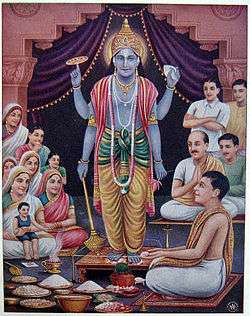
Legend
This puja is first mentioned in Skanda Purana, Reva Kanda by Suta Puranik to the rishis in Naimisharanya. The details are part of the Katha (Story) that is usually read during the ritual[4]
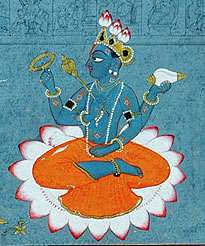
Sri Satya Narayana puja is a very popular ritual in most parts of India including Gujarat, Maharashtra, Assam, Bengal, Karnataka, Andhra Pradesh,Telangana,Bihar, Odisha, Manipur..
The ritual is usually performed on the Full moon day of every month, Ekadashi (11th day after full moon or new moon), Kārtika Pūrṇimā, Vaiśākhā Pūrṇimā, solar eclipse day or on Saṅkrānti except during Āṣāḍha Chandra Masa[5]. It is also performed on special occasions and during times of achievements, as an offering of gratitude to the Lord. These occasions could include marriage, graduation, start of a new job, purchase of a new home, to name a few. In addition, the performance of this most auspicious puja generally confers a child to couples trying to start a family[6].
The Satyanarayan puja can be performed on any day for any reason. It is not a puja confined to any festivities, but Purnima (full moon day) is considered specifically auspicious for this puja. Performing this puja in the evening is considered more appropriate. However, one can perform this puja in the morning as well.
This puja is very simple, can be performed by anyone, and it does not require a priest to perform it. The original concept was instructions given by rishi Narada Muni while on tour of earth he noticed tremendous amounts of sufferings all around due to malnutrition. He went to lord Vishnu and described the situation and was told with instructions to perform Pooja and the other stories to be narrated. One of the key instruction was to invite as many friends, relatives and neighbors to attend the ceremony and to feed them and to offer as many types of fruits as possible and the sufferings will be eliminated, and this was due to being well fed and consumption of fruits.
Preparation
The previous night, think of Lord Sri Satyanarayana and mentally decide to perform puja the next day. Invite your relatives and friends. Tradition mandates to abstain from worldly pleasures.
On the puja day, early in the morning keeping the same thoughts of worshiping the Lord, take a head bath. If performing the evening, again take a head-bath. This should be done by both husband and wife. Wear a clean dress.
Observe Fast (if possible).
Keep all the things for puja ready, near the altar. The total duration of the puja - start to finish – will be around 3 hours.
Decorate the front door with mango leaves. The place near the altar is cleaned (with cow dung, where possible).
The Altar is placed in an East-West direction such that the devotees performing the puja will be seated facing east. It is decorated with floral designs, usually using rice flour and other coloured powders. A new white cloth is spread on the Altar and layered with raw rice.

A Kalash (small pot made of Silver, Copper, Brass, or even earthen) is placed in the middle of Altar. That small pot should add one betel nut, one rupee coin, some jwar or wheat and then filled it with holy water like gangajal, if not available you can use clean water .A coconut is placed on top and wrapped with a cloth.5 Mango or ashok leaves are placed between the coconut and the pot. After this a red thread (kalava or moli) is tied 3 round in neck of pot . Make a symbol of swastik in pot, it is a good and positive symbol .This too is decorated with Chandan (Sandal paste) and kumkum. This process is called kalash sthapna .
A framed picture of Lord Satyanarayana is placed on the far side of the Altar. Flowers and garlands can be placed on this frame.
Place all the puja items near the Altar.
The devotees performing the puja will be seated facing the Altar.
Prasad
The food is cooked as normal, usually rice, dal and vegetables; avoiding any non-vegetarian (egg, meat, and fish dishes) and also avoid onion and garlic.
Make sure the kitchen is kept clean and devoid of impurities.
The main Prasad[7] [offering] (is also called as Sapatha, Sheera or Sapaada Bhakshya[ಸಪಾದ ಭಕ್ಷ್ಯ]) is prepared with equal parts (usually one and one-forth parts) of sugar, Semolina, and Ghee. Popularly, it is cooked to blanch. Cardamoms, cashews, raisins, and/or bananas may be added while cooking or as garnishing. Some people avoid cooking and merely mix the ingredients together.
Various regional variations exist in the way it is cooked. It also has various names - Telugu Prasadam,[8] Marathi Sheera,[9] Gujarati Sheera,[10] Bengali Sinni,[11] Punjabi Panjiri,[12] etc.
The main Prasad is offered together with daily food, various fruits, and Panchamrutam (uncooked mixture of Milk, Yogurt, Ghee, Honey, and Sugar).
Items needed for puja
The following is a list of items needed for the puja.[13][14][15][16][17]
- Haldi (Turmeric powder)
- Kumkum ( Red vermillion or Sindoor )
- Navadhanya ( a mixture of nine herbs offered to navagraha ( nine planets ) )
- Incense sticks
- Camphor
- Sandal paste
- A photoframed picture of Lord Satyanarayana
- A small idol (or coin) of Lord Satyanarayana (optional)
- wheat or jwar (not rice)
- Betel leaves (100)
- Betel nuts (50)
- Coins (40)
- Dry Dates/ Almonds (50)
- Coconuts (8)
- Flowers, tulasi leaves Garland
and floral garlands
- Two jars (Silver, Copper, Brass, or even earthen) – one for Kalash and another for the ritual
- Two flat plates
- A bell
- A large pidha table (for use as Altar)
- A large yellow cloth (to cover the Altar) pit is the favourite colour or satnarayan he wears pitambar or yellow clothes
- A piece of yellow or red cloth (for the kalash)
- A ghee lamp (with at least three wicks)
- An oil lamp
- Cotton wicks
- Panchamrita (Uncooked mixture of milk, yogurt, honey, sugar, and ghee)
Good to have
- Conch shell
- One thousand Tulasi (Indian Basil) leaves.tulasi manjari (flower of tulasi)
- Banana tree / leaves as a canopy.white tila two table spoons.white tila or white sesame seeds is favorite of Lord Satnarayan. Rose is his preferred flower.
Procedure
The following procedure is as prescribed by and performed in Andhra Pradesh.[18] Several regional and traditional variations occur as mentioned in the following section.
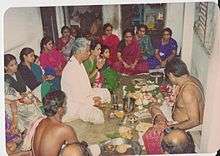
The devotee begins by purifying oneself (achamniyam) and sankalpam (a vow that the named devotee is performing the puja on such time and era, to attain such cause).
The puja starts with a prayer to Gaṇesha, to remove all obstacles that may occur as a result of incorrectly performing the puja. This is done by the sixteen upacharas, chanting the names of Lord Gaṇesha and offering prasada (offering usually consisting of banana, coconut, modak, a sugar and coconut mixture, or laddu) and the showering of flowers. Subsequently, Varuna puja (kalash puja) is performed.
A uniqueness of this puja is the invoking of pancha lokapalaka, navagrahas along with their companion and co-companions, and the eight dikpalakas. This totals to 40 (5+9+(9*2)+8). Each God has a vedic symbol of a unique metal. Since these are difficult to obtain by the common means, and since the modern currency coins by minted with multiple metals, each Guest God is represented by a coin. They are placed on a betel leaf. The betel nut, akshit and dry dates are the offerings. Thus, the requirement of 40 coins, betel leaves and dry dates.
The main puja commences with the worship to Lord Satyanarayana. The idol (or coin) of Lord Satyanarayana is bathed and cleaned with panchamritam. After placing the deity in the correct position, 1008 names of Sri Satyanarayana are chanted.
This is followed by offering of Prasada and flowers (Mantra Pushpam).
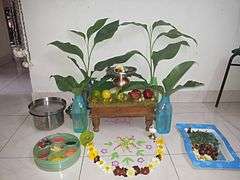
Another requirement of the puja is that the story be heard among all those observing and partaking in the puja.[19]
The five-part story involves the origin of the puja, benefits of the puja, the potential mishaps that may occur with the forgetting performance of the puja, the magnitude of the Lord's benevolence and the importance of the Prasad, and consequences of snubbing the ritual.[20]
The puja concludes with an Aarti [21], which consists of lighting camphor in the vicinity of an image of the Lord.
After the puja is over, participants and observers of the puja are required to partake the prasad that was offered and blessed by the Lord.
Regional and Traditional Variations
- Many places the Varuna/ Kalash puja is done while invoking Ganesh at the start of the puja.
- The number of Athitis (divine guests) invoked varies substantially. Thus, the number of coins and betel leaves count varies.
Sri Satyanarayana Swami Katha
An essential part of this puja is listening to the Sri Satyanarayana Swami Katha (narrative).[22]
The five-part story involves the origin of the puja, benefits of the puja, the potential mishaps that may occur with the forgetting performance of the puja, the magnitude of the Lord's benevolence and the importance of the Prasad, and consequences of snubbing the ritual.[23]
Chapter 1 narrates the origins of the puja. Sri Satyanarayana Katha comes from the Skanda Puraṇa, Reva khaṇḍa.[24] Suta Maharṣhi is the one narrating this account to Saunaka Muni, in Naimiṣaraṇya to the ṛiṣhis who were performing a thousand-year yajna for the benefit of humanity. The procedure itself was narrated my Sriman Narayana to Narada.
Chapter 2 narrates the benefits of the puja. A poor Brahmin was approached by Lord Himself in disguise and He advised him of the puja. Upon successful completion of the puja, the Brahmin could overcome his difficulties and enjoy eternal bliss. It also narrates about the good fortune of a woodcutter who witnesses the Brahmin performing the puja and continues to gain prosperity after performing the puja.
Chapter 3 narrates the mishaps that may occur for dishonoring the vow to perform the puja. A merchant, with an intention to establish family, vows to perform the puja upon having a child. He adjourns the vow to complete it during the child's marriage. Upon forgetting the vow, the Lord puts the merchant in hardship. The merchant is falsely accused and imprisoned. His entire business is confiscated by the king. His household goes bankrupt. He is freed when his wife recollects the promise and performs the puja.
Chapter 4 narrates about the Lord's benevolence and the importance of the Prasad. This is a continuation of the previous chapter. During an incident, the merchant puts off the Lord about his merchandise, thereby losing all its value. Realizing his folly, the merchant regrets his intemperance and seeks forgiveness. On hearing that the merchant reached the dockyard, his wife and daughter, who were performing the puja at that time, forget to take the Prasad. Angered with the disrespect, He makes the boats sink into the sea, only to be restored when they have the Prasad.
Chapter 5 narrates about the importance of the puja and not that of the devotees. A group of backwoodsmen was performing the puja. King discards and disregards the offerings, thereby invoking the wrath of Sri Satyanarayana. The king loses his kingdom, wealth, and family, only to be restored upon realizing his recklessness and seeking forgiveness to Sri Satyanarayana and accepting the offerings.
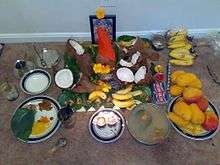
Concluding the Pūjā: Āratī & Stuti
The rituals concludes with the Puja participants including the story audience singing Invocation prayers (Aarti)[25] to Satya Nārāyaṇa.
See also
- Puja
- Annavaram Satyanarayana Temple
- Gudem Satyanarayana Swamy
- Satya Pir
References
- http://www.hinduwebsite.com/symbolism/satya-narayana.asp
- http://www.mantraaonline.com/satyanarayana-puja/
- http://www.satyanarayanpuja.org/significance-of-satyanarayan-puja.html
- http://www.mantraaonline.com/satyanarayana-puja/
- http://pujabooking.com/blog/sri-satyanarayan-vrata-puja/
- http://pujabooking.com/blog/sri-satyanarayan-vrata-puja/
- http://www.satyanarayanpuja.org/satyanarayan-puja-prasad.html
- https://www.youtube.com/watch?v=S9HsBZcgBto
- https://www.youtube.com/watch?v=lw7vdmA2Os4
- https://www.youtube.com/watch?v=lw7vdmA2Os4
- https://www.youtube.com/watch?v=SpCrRJeKCvY
- https://www.youtube.com/watch?v=LXH_co9DhEY
- http://www.drikpanchang.com/vrat-katha/satyanarayana/pujan-samagri/hindi/satyanarayan-vrat-pujan-samagri.html
- http://www.satyanarayanpuja.org/satyanarayan-puja-items.html
- http://www.ranganatha.org/Portals/0/SRTDocuments/2011/SriSatya-NarayanaPooja.pdf
- http://www.chivukulas.com/2014/12/how-to-perform-satyanarayana-swamy-vratam-at-home.html
- http://pujabooking.com/product/book-satyanarayana-puja-online/
- http://mantraaonline.com/wp-content/uploads/Puja/Satya/satyaeng.pdf
- http://umasreeraghunath.blogspot.com/2011/11/benefits-of-performing-sri.html
- http://www.angelfire.com/pa3/payalvinod/sai.html
- http://pujabooking.com/aarti-collection/god-aarti/shri-satyanarayan-ji-ki-aarti/
- http://annavaramdevasthanam.nic.in/history.htm
- http://www.puja.net/Pages/Yagyas/Journal/04Events/Satyanarayana/SatyaPuja.htm
- http://www.mantraaonline.com/satyanarayana-puja/
- http://pujabooking.com/aarti-collection/god-aarti/%e0%a5%90-%e0%a4%9c%e0%a4%af-%e0%a4%9c%e0%a4%97%e0%a4%a6%e0%a5%80%e0%a4%b6-%e0%a4%b9%e0%a4%b0%e0%a5%87/
- http://www.internetwebportals.com/2016/10/satyanarayan-puja-dates.html
Further reading
- Thousand Names of Vishnu and Satyanarayan Vrat (ISBN 1-877795-51-8) by Swami Satyananda Saraswati, Devi Mandir.
External links
- Annavaram Devasthanam Official site for Annavaram Devastanam
- Sri Satya Narayan Katha & Vidhi Sri Satyanarayan Puja Vidhi and Katha.(Hindi)
- Sri Satya Narayana Pooja Manuals Free do-it-yourself manuals for Sri Satya Narayana pooja/vratam. Three versions are available - regular, short and super-short. Several other do-it-yourself ritual manuals are also available on the same website.
- Sri Satyanarayan Puja Items List of items needed to perform Sri Satyanarayana Puja ritual successfully. Also know more about Satyanarayan Puja Preparation, Prasad Preparation & Puja Vidhi available on the same website.
- Sri Satyanarayan Puja Satya Narayana Puja is usually done on the Purnima day of every month, Satyanarayan the form of lord Vishnu is worshiped with great devotion in this puja.
- Satyanarayan katha and puja vidhi Satyanarayan bhagwan katha and puja vidhi in hindi

